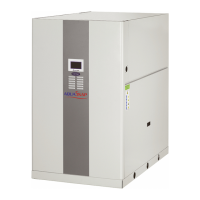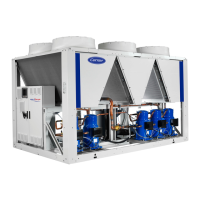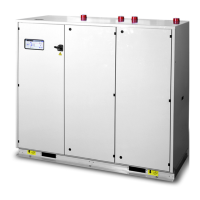9
2 - PRELIMINARY CHECKS
2.1 - Check equipment received
Inspect the unit for damage or missing parts. If damage is detected,
or if shipment is incomplete, immediately le a claim with the
shipping company.
Compare the name plate data with the order. The name plate is
attached in two places to the unit:
- on one of the unit sides on the outside
- on the control box door on the inside.
The unit name plate must include the following information:
- Fluid being transported
- Version number
- Model number
- CE marking
- Serial number
- Year of manufacture and test date
- Refrigerant used and refrigerant class
- Refrigerant charge per circuit
- Containment uid to be used
- PS: Min./max. allowable pressure (high and low pressure
side)
- TS: Min./max. allowable temperature (high and low pressure
side)
- Pressure switch cut-out pressure
- Unit leak test pressure
- Voltage, frequency, number of phases
- Maximum current drawn
- Maximum power input
- Unit net weight
Conrm that the options ordered for on-site installation have been
supplied, are complete and undamaged.
Do not keep the units outside where they are exposed to the
weather, as the sensitive control mechanism and the electronic
modules may be damaged.
The unit must be checked periodically during its whole
operating life to ensure that no shocks (handling accessories,
tools etc.) have damaged it. If necessary, repair or replace
the damaged parts (see chapter “Maintenance”).
The machine must be installed in a place that is not accessible
to the public or protected against access by non-authorised
persons.
2.2 - Moving and placing the unit
2.2.1 - Moving
See chapter 1.1 - “Installation safety considerations”.
2.2.2 - Placing the unit
Always refer to the chapter “Dimensions and clearances” to
conrm that there is adequate space for all connections and
service operations. For the centre of gravity coordinates, the
position of the unit mounting holes, and the weight
distribution points, refer to the certied dimensional drawing
supplied with the unit.
Typical applications of these units are in refrigeration
systems, and they do not require earthquake resistance.
Earthquake resistance has not been veried.
In case of extra-high units the machine environment must
permit easy access for maintenance operations.
CAUTION: Only use slings at the designated lifting points
which are marked on the unit.
Before siting the unit check that:
- the permitted loading at the site is adequate or that
appropriate strenghtening measures have been taken.
- the unit support points are located at the four lower corners.
- the positioning at these four points must be horizontal (level
tolerance 1.5 mm/m in both axes)
- if the support structure is sensitive to vibration and/or noise
transmission it it advisable to insert anti-vibration mounts
(elastomeric mounts or springs) between the unit and the
structure. Selection of these devices is based on the system
characteristics and the comfort level required and should be
made by technical specialists.
- there is adequate space above the unit for air ow and to
ensure access to the components.
- the number of support points is adequate and that they are
in the right places.
- the location is not subject to ooding.
- No material or object that can be affected by condensate
(even a small amount) must be left under the machine or in
the water ow direction.
CAUTION: Before lifting the unit, check that all casing panels
aresecurelyxedinplace.Liftandsetdowntheunitwith
great care. Tilting and jarring can damage the unit and impair
unit operation.
If units are hoisted with rigging, it is necessary to protect the
unit frame (side and rear panels and front doors) against
accidental crushing. Use struts or lifting beams to spread the
slings above the unit. Do not tilt a unit more than 15°. Always
follow the instructions on the handling notice attached to the
unit.
If a unit includes a hydraulic module (options 116 or 270), the
hydraulic module and pump piping must be installed in a way
that does not submit it to any strain. The hydraulic module
pipes must be tted so that the pump does not support the
weight of the pipes.
Never push or lever on any of the enclosure panels (panels,
uprights, front access doors) of the unit. Only the base of the
unit frame is designed to withstand such stresses.

